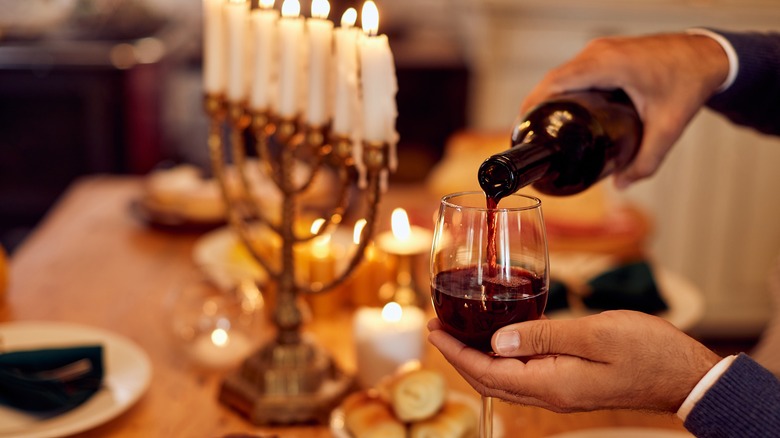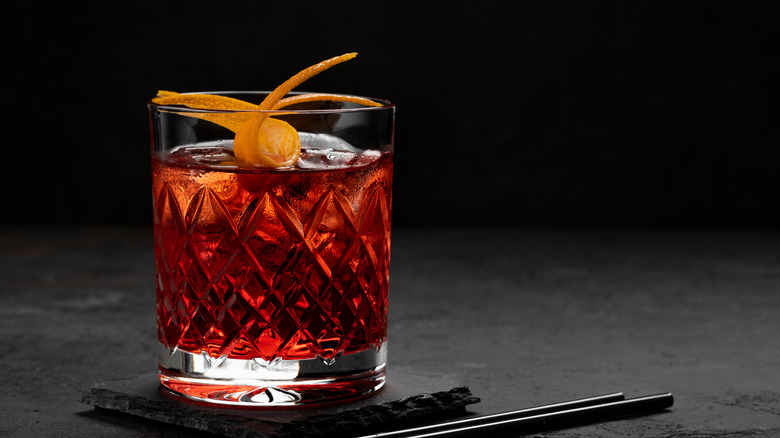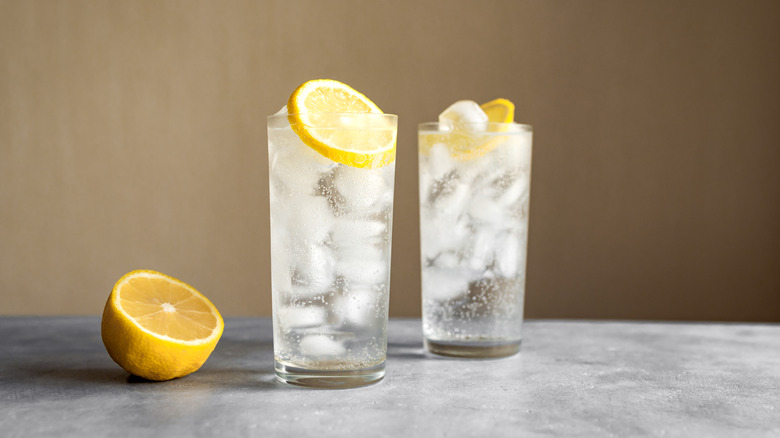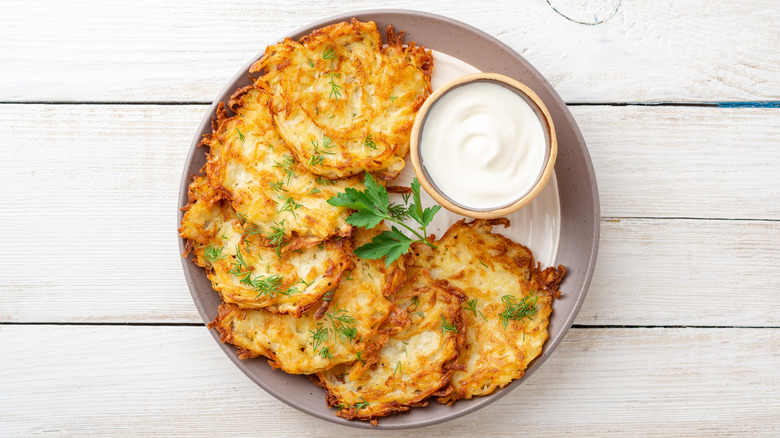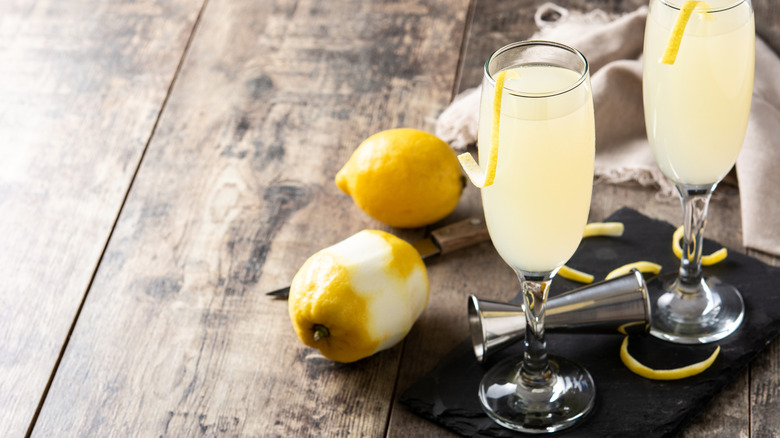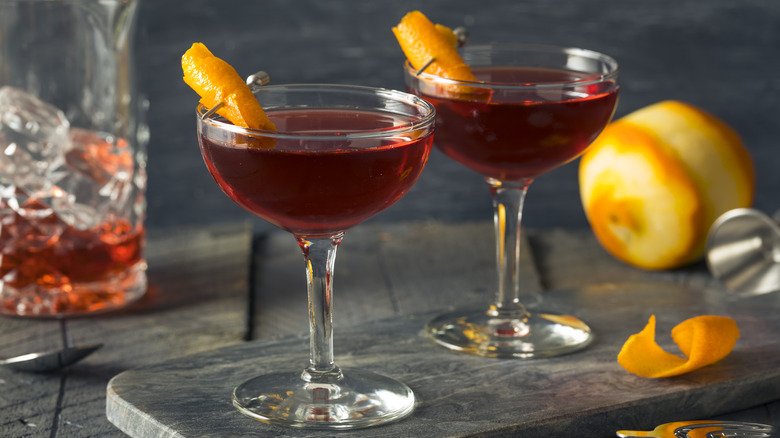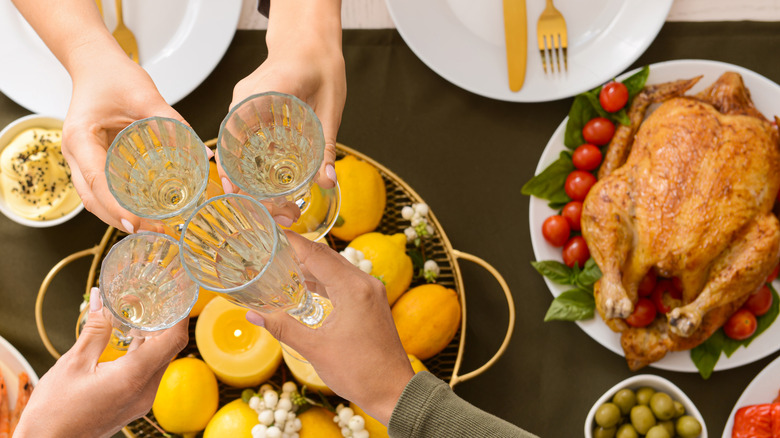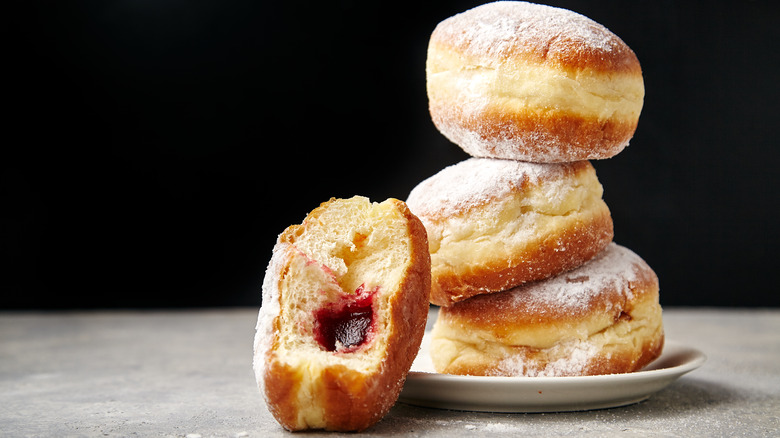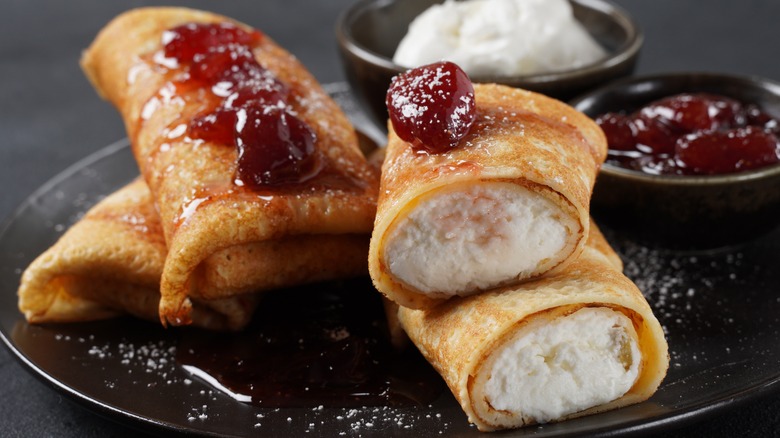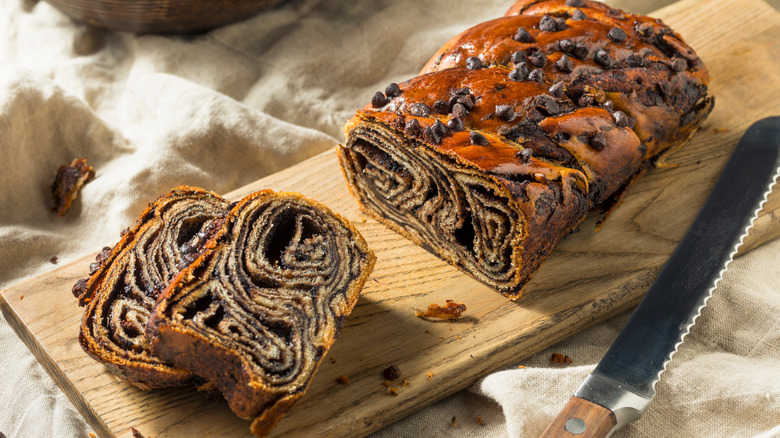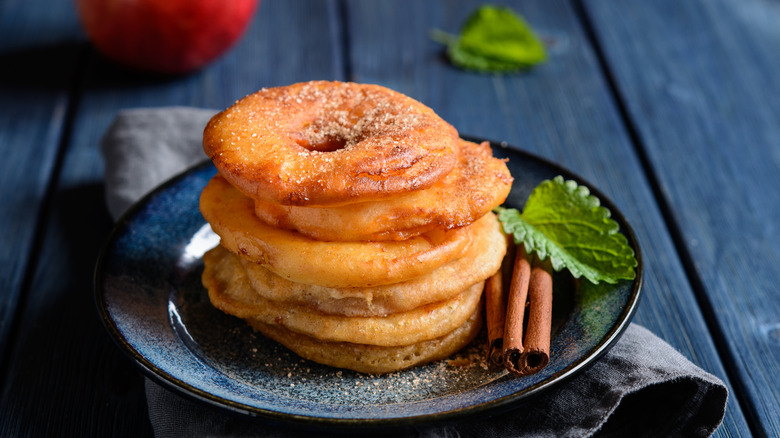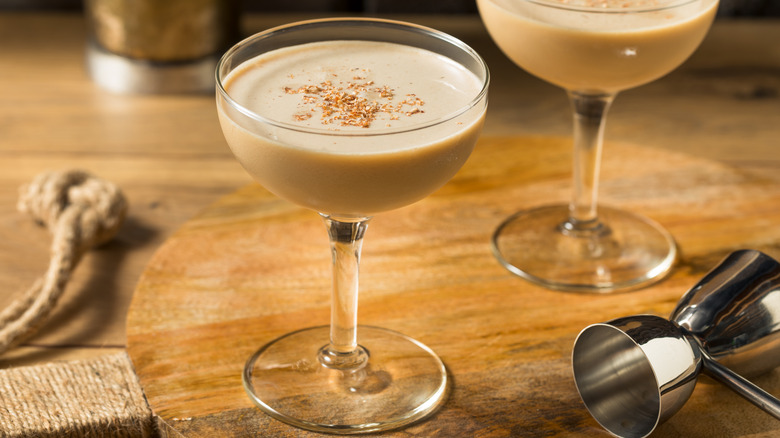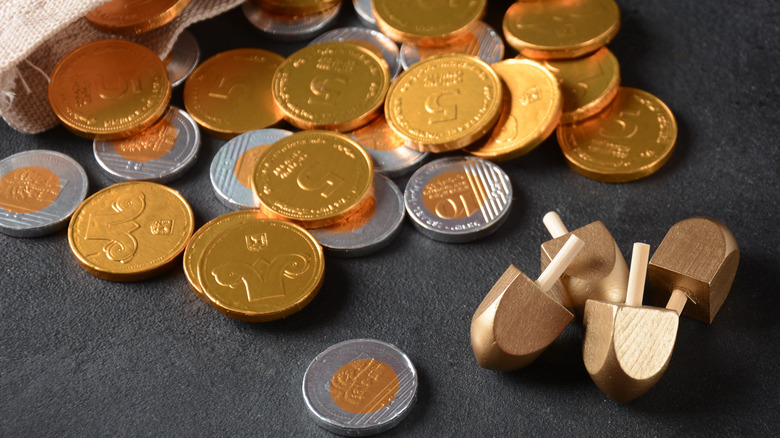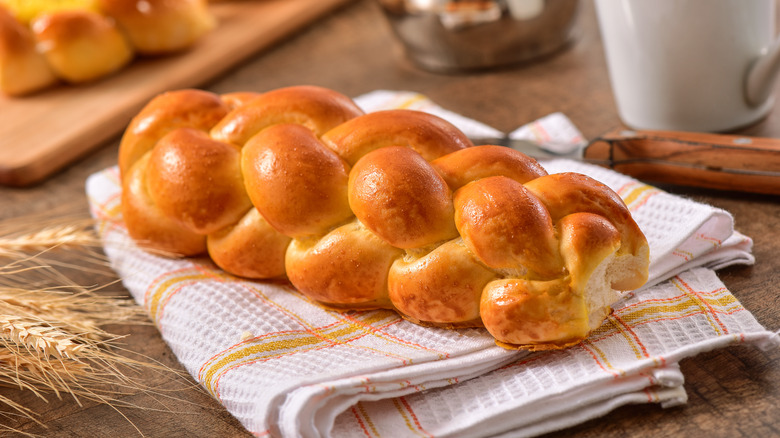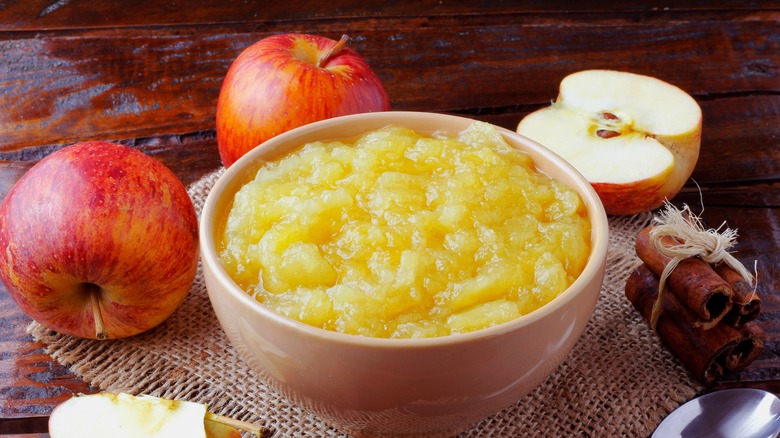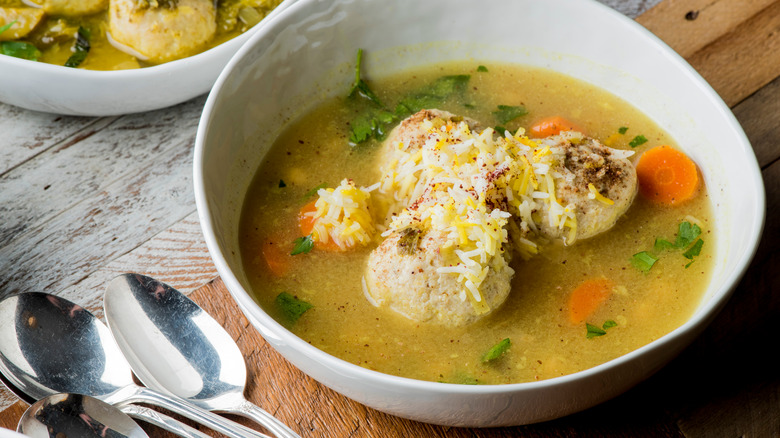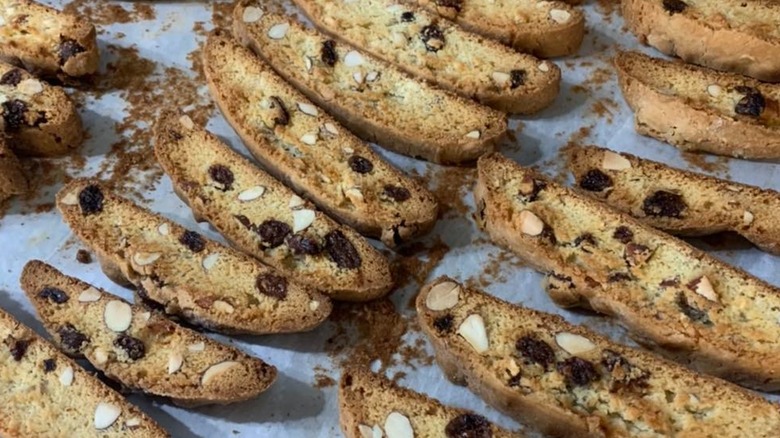16 Best Boozy Drinks To Pair With Your Hanukkah Meal
Hanukkah is an eight-day-long Jewish holiday commemorating the Maccabees' rebellion against the Greek Syrian rule and the victorious event of taking over the Temple of Jerusalem. The miracle of light associated with Hanukkah relates to the story in Talmud that recounts how one vial of oil, which was supposed to last a day, miraculously burned for eight successive days after the temple was rededicated. The triumph and the related events became the origin and framework for the Hanukkah festival. This once-minor Jewish holiday is now increasing in popularity. Along with lighting the menorah and playing dreidel, one of the standard practices is gathering around a festive Hanukkah meal (via National Geographic).
Hanukkah doesn't imply strict food practices, but the tradition of serving fried dishes is the guiding principle for every Hanukkah feast. Fried dishes are prepared to honor the miracle of light that happened at the Temple of Jerusalem. This is why all those latkes and various fritters decorate the festive Hanukkah table. The festival doesn't shy away from non-fried dishes and often includes brisket or roasted chicken as centerpieces and rugelach or babka as sweet components. Although wine is a Hanukkah standard, we've rounded up slightly more adventurous, potent drinks that would make perfect partners to all those fried and baked Hanukkah delights.
1. Negroni as an apéritif
Serving an apéritif before the meal is an ideal way to start Hanukkah festivities. The apéritif ritual stems from European drinking tradition, but the concept transplanted so well that it is now standard in all parts of the world. The word apéritif comes from the Latin "aperire," meaning "to open," and the idea of an apéritif is to whet your appetite before the meal, preparing the palate for all the flavorful things to come. Traditionally, aperitifs are dry, bitter, and not overly strong. Wines, especially sparkling or rosé, can make an excellent apéritif. Some cocktails also fall into the category, such as the legendary martini, but our Hanukkah recommendation is to go for the potent and brawny negroni (via Britannica).
Although apéritifs tend to be low in alcohol, a negroni can hardly be described as a light drink, but due to the combination of ingredients, it makes a perfect aperitif that will surely prepare you for all the delicious things that follow. A negroni is usually made with equal parts Campari, gin, and sweet vermouth. The final result is a perfectly balanced drink bursting with bitterness, crisp orange notes, and herbaceous, earth-like nuances, all complemented by toned-down sweetness. Campari lends the drink the distinctive bitter characteristic and bright orange notes, both in aroma and flavor. Gin amps up the ABV, while vermouth delivers some subtle spices. A negroni is best prepared stirred and should always come garnished with an orange twist (via Difford's Guide).
2. Knish and a Tom Collins
Knish is a stuffed pastry that has its origins in Eastern Europe. At the beginning of the 20th century, Ashkenazi Jews brought it to North America, where the dish found its spiritual home, namely in NYC. Contemporary knish is large and traditionally made with a thin pastry shell packed with a potato-based filling. It can be baked or fried, while the filling variations include spinach, sweet potatoes, mushrooms, cheese, meat, or buckwheat (via Britannica). Because of various fillings and different preparation techniques, knish can be a problematic pairing partner, but each of these knish styles would be a good match with a light and crisp cocktail, and Tom Collins perfectly fits the description.
Tom Collins is a straightforward cocktail that combines gin (preferably London dry style), simple syrup, lemon juice, and soda water. The ingredients are assembled in a tall Collins glass filled with ice, and the cocktail is traditionally garnished with a lemon wheel. This classic blends into a light, fizzy drink packed with bubbles, citrusy flavors, and herbaceous and spicy notes delivered by gin. Because of its character, Tom Collins works wonderfully as a pairing partner with heartier and more filling snacks, including the standard potato knish. The distinctive citrus profile and the bubbles should clean the palate between every bite, and they are strong enough to pierce through the fat-packed crust and the richness of the starchy potato filling.
3. Latkes and vodka
Other Hanukkah dishes are easily switched, added, or removed, but latkes are a staple and almost synonymous with Hanukkah. These grated potato pancakes are loved for their crispy texture, earthy flavor, and overall unpretentious character. They can be a great playground for various add-ons and an excellent partner with sour cream or a dollop of applesauce. Classic latkes are made with grated potatoes, flour, eggs, and seasonings, and you can easily play with the ratio to create the texture you want. They make an excellent side dish, a snack, or a meal on its own.
Latkes weren't always a Hanukkah staple. As explained by the Los Angeles Times, potato pancakes originated among Eastern European Jews as a cheap and affordable dish that could feed many. As the Hanukkah tradition evolved, people around the world used ingredients that they had on hand and made them into fritters. For Eastern Europe, the obvious choice was to go with the plentiful, sturdy potatoes.
With latkes, you need something that will balance all those strong elements; fattiness, saltiness, and crispiness. Vodka, which is often distilled from potatoes, comes as a natural pairing here. Partially because of vodka's clean character but also because the two share a similar historical background and the same eastern European origin. Distiller argues that latkes can work with various vodka styles, including those distilled from potatoes, wheat, or corn. It suggests that the ideal vodka for this pairing should be pleasantly smooth and subtly sweet.
4. Kugel and a French 75 cocktail
Kugel is a Jewish staple that is often included on Hanukkah menus. It is a casserole-like dish traditionally baked in round pans — the word kugel in German stands for a ball — that can use noodles or potatoes as the base. Kugel was brought to the U.S. by European Jews, and the dish has since become an important part of the Jewish holiday tradition in the States (via The New York Times). Potato kugel is more traditional for Hanukkah. It consists of potatoes and onions combined with a delectable mix of eggs and oil or chicken fat. The combo is baked until golden, and the hefty casserole is served sliced along with other Hanukkah specials. As you're dealing with a heavy, rich, and robust dish, the pairing partner needs to be fresh and crisp to break through all those fat-laden layers, and French 75 comes as an ideal pairing option in this scenario.
The French 75 is a classic cocktail that never went out of style. According to Difford's Guide, the French 75 has gone through many iterations to get to where it is today — a refreshing blend of gin, lemon juice, simple syrup, and Champagne built in a traditional flute glass, which only adds to its charm and perfectly fits in any festive environment. Although relatively simple to make, a French 75 cocktail is packed with flavor. Along with herbal and citrus nuances, those fine Champagne bubbles make a bright, crisp cocktail that can match the richness of the potato kugel.
5. Brisket and a Boulevardier
Brisket is central to the Jewish culinary narrative and is a staple on many Jewish holidays, including Hanukkah. St. Louis Jewish Light explains that this inexpensive cut of meat became the central part of every Jewish celebration because of kosher laws and simple economics. The European Jews first used brisket as the main holiday protein due to its cost. As it is a tough cut, it requires long cooking and technical skill, so it was usually slightly less desired than other cuts. The brisket tradition was brought over to the U.S., where it was also used in the preparation of corned beef and pastrami, but the slow-roasting method remained a staple for most members of Jewish communities. There is no set recipe for the holiday brisket, but the dish is usually slowly roasted with root veggies. It often includes tomatoes and red wine that turn into a flavor-packed rich sauce. Because of its robust character, brisket requires an equally strong boozy drink, and Boulevardier is the ideal cocktail option in this pairing equation.
Boulevardier is a potent, brawny cocktail with a Campari base that is strong enough to pair with braised brisket. This blend of Campari, sweet vermouth, and whiskey is a grown-up drink that is not light on flavor or ABV. It would make a good pairing with brisket as the two share similar flavor profiles; strength, bitterness, and subtle sweetness accompanied by some fruity and earthy aromas.
6. Roast chicken and a Champagne cocktail
Throughout the 19th and 20th centuries, Hanukkah was regarded as a less important Jewish holiday, so the info about Hanukkah dishes is relatively scarce. Most of the recipes traditionally eaten for Hanukah these days stem from German-Jewish cooking tradition. While you may be familiar with brisket as the dish most associated with Hanukkah, many festive Hanukkah tables also feature poultry, usually roasted chicken and turkey. This tradition also relates to the German-Jewish custom of eating roasted goose. Apparently, Jewish people "borrowed" the practice from Christianity, which proved convenient as geese were bred for the season. This practice was lost to history, but in the U.S., it was replaced with roasted chicken or turkey (via Leo Baeck Institute).
Roasted chicken is not a demanding pairing partner. The delicate meat rarely overpowers any drinks, and though some elegant dry or sparkling wine might sound like a reasonable choice here, go with the Champagne cocktail. If you want to opt for a more potent option that has more character than a standard glass of bubbly or dry wine but is still light enough to pair with poultry, you'll want a delightful mix of Champagne, bitters, and sugar. Though brandy is a standard addition these days, it wasn't included in the first recipes (via Difford's Guide). The Champagne cocktail is a bit stronger, but because of its dry, fizzy, and subtly sweet profile, it is a great food pairing option if you want to break standard tradition.
7. Sufganiyot and a Jam Donut cocktail
Next to latkes, sufganiyot are one of the essential additions to every Hanukkah meal, as these jam-filled doughnuts perfectly fit into the tradition of serving fried dishes on Hanukkah. Sufganiyah doughnuts are made with yeasted dough and are fried in copious amounts of sizzling oil. When perfectly puffy and golden, each is filled with fruit jam and dusted with a hefty dose of powdered sugar. The tradition of eating jam-filled doughnuts for Hanukkah is somewhat vague, but it probably evolved from similar North African fritters and was inspired by the Germanic krapfen — most likely the first jam-filled doughnut ever created that was later reinvented in other parts of Europe. The dish was adopted by European Jews, mostly Polish, who later took the tradition to other parts of the world (via Time).
For this fruit-packed, decadent doughnut, we recommend an equally luscious Jam Donut cocktail. This blend of Chambord liqueur and cream mimics the flavors of the standard jam doughnut, so the profiles should work in perfect balance (via Cocktail.uk). Chambord liqueur provides all the flavor in this cocktail combination, as it is packed with blackberries, raspberries, and blackcurrants that are steeped and mixed with Cognac, vanilla, citrus, and honey. As doughnuts are deep-fried, they are not overly light, so they can hold up next to the sweetness and richness of the Jam Donut cocktail.
8. Blintzes and mimosas
At its basic, blintzes are thin crêpes packed with a sweet cheese filling. When filled, the crêpes are neatly wrapped and pan-fried until golden. They are typically served doused in sour cream and fruit jams. If you want to make blintzes the star of your Hanukkah meal, try to tweak the fillings and the toppings. The Detroit News recommends switching the standard farmer's cheese with mascarpone for a richer and creamier filling or going for brie for the more adventurous option. Toppings can be easily modified to suit your taste and blend into the menu. Blueberries are a standard, but don't shy away from other fruit preserves or honey for sweeter, syrupy blintzes.
Blintzes sound like they were made for brunches, and we chose to pair them with the boozy brunch star, the lightly fizzy, orangey mimosa. This brunch staple is one of the easiest cocktails; pour Champagne into a flute glass, fill it halfway, and then top it with orange juice. A mimosa is a delicate and unpretentious drink that nicely blends sweet citrus flavors with the sharpness of the bubbles, and it should work great when paired with a crispy crêpe shell and the creaminess of the cheese and sour cream. The best option for this pairing is to go with dry (extra brut or brut) Champagne, as you don't want an overly sweet drink.
9. Babka and whisky
Babka is a sweet, braided bread typically filled with chocolate or the aromatic cinnamon and sugar mix. It is a beloved Jewish staple, praised for its charming looks and the flavor combination of yeasted dough and fragrant fillings. Skillfully twisted dough tangled with chocolate or cinnamon spreads makes a very aesthetical dessert fit for any festive table. Unsurprisingly, babka is often the main dessert on various Jewish holidays, including Hanukkah. This sweet bread has Polish origins, but after it was brought to the U.S., it became a star product that found its place in most Jewish bakeries (via My Jewish Learning).
Though we have nothing against traditional cinnamon babka, we'll assume that you're going for the chocolate-filled version for your Hanukkah dinner, as it's the most popular option. We recommend Scotch whisky as an equally famous pairing with this classic chocolate bake. The two exist in perfect harmony, and the bitter cocoa notes inside the chocolate spread should enhance the grainy sweetness of the whisky. Babka is not a sugary sweet dessert, but it is still a sweet, leavened bread so try to go with a mellow whisky option and avoid something too robust or peaty. Flaviar recommends Lowland whisky as an approachable version that easily pairs with chocolate.
10. Apple fritters and bourbon
Apple fritters aren't strictly associated with Hanukkah, but they commonly appear as a sweet snack during festive Hanukkah meals. Apples are an autumnal fruit, and as we're dealing with a deep-fried dish, these crisp aromatic fritters perfectly fit the tradition of serving fried dishes on Hanukkah. Apple fritters can be made with diced or grated apples incorporated in the batter, or you can coat whole apple rings in batter and then fry the pieces until the coating becomes golden and crisp. Of course, the addition of cinnamon is a must. The combination of cinnamon and apples is a textbook example of a perfect pairing, and both ingredients nicely pair with a glass of bourbon.
Cinnamon in this dessert would work with most bourbons because of similar spicy notes. However, it would pair exceptionally well with rye, which tends to be stronger and more peppery. Bourbon's caramel-like notes traditionally play nicely with apples and the crispy, sugary layer that protects the juicy apples (via The Whiskey Wash).
11. Rugelach and a Brandy Alexander
Along with the feather-light sufganiyot, rugelach is probably the most common sweet addition to the Hanukkah table. The pastry for rugelach is made with cream cheese, while the fillings vary but typically include heartier ingredients, such as cinnamon, chocolate, or pecans. Fruit jams are also standard. The paste-like filling is spread on the dough, which is rolled into small croissant-like nibbles that are baked until golden and crispy. Because of their shapes, you get a perfect ration of pastry and filling with each bite. Although rugelach is a dessert cookie, it is not overly sweet and could work with a creamy cocktail like a Brandy Alexander.
A Brandy Alexander is a spin on the classic Alexander cocktail. It combines brandy, crème de cacao, and cream. The result is an incredibly creamy cocktail with a smooth and velvety mouthfeel that nicely blends rich cocoa notes with the complex caramel, nutty, and spice-like nuances delivered by the brandy. To make the best Brandy Alexander got with high-quality brandy and as recommended on Liquor, don't go overboard with sweetness and liqueurs. The brandy gives this cocktail character, so you should let it shine through. The creaminess of the cocktail will perfectly pair with the flakiness of the rugelach, while the similar flavor profiles should work in perfect balance.
12. Hanukkah gelt and rum
Chocolate coins tucked inside a gold (or sometimes silver) colored wrapping paper are a Hanukkah staple with an ancient tradition that had nothing to do with chocolate. As Gina Glasman from Binghamton University explained to NPR, Hannukah gelt practice originated in Eastern Europe, but it was initially a financial reward for various workers given at the end of the year. As communities grew and modernized, these practices were abandoned, and holiday traditions were adapted. A major shift came with immigration, and as gift giving focused on children, the geld (gelt) — German for money — was turned into chocolate coins. Today, they are given to children, used for the obligatory game of dreidel, and used as Hanukkah decoration. Of course, as the night ends, you'd probably nibble on chocolate coins, and the best drink to pair with it would be a glass of fine rum.
Ideally, you would serve rich aged rum with these dark chocolate coins. The caramel-like notes in the rum will partner nicely with dark chocolate flavors. Because both elements are strong and robust, there is less chance that the rum will overpower those bitter cocoa nuances. Alternatively, you can opt for a rich rum-based cocktail, such as Dark 'n' Stormy.
13. Challah with a Salty Dog
Challah is a traditional bread featured on tables for Jewish celebrations throughout the year, including Hanukkah. This rich loaf is similar to brioche — the difference between challah and brioche is that brioche uses butter, while challah is dairy-free so people who keep kosher can eat it with all kinds of food. Lobe-shaped slices of challah can be topped with everything from simple butter and jam to decadent chocolate hazelnut spread. At Shabbat dinners, one of the rituals is to combine challah and salt, a symbolic act of that expresses gratitude to the divine creator. It's a small rite that holds great significance.
Inspired by this tradition, a Salty Dog is an ideal cocktail to enjoy with challah. The glass is rimmed with salt like a margarita, merging salt with the bread in a creative fashion. A tart formulation of grapefruit juice mixed with your choice of gin or vodka plays against the richness of the bread to create a harmony of contrasting flavors. Because this drink is such a simple concoction, you can set up a station for guests to pour their own Salty Dogs, adding as much salt, juice, and liquor as they prefer. A salted glass with just grapefruit juice and ice will allow younger guests and non-drinkers to add a tingle of juicy joy to their meal as well.
14. Homemade applesauce and mulled wine
The best topping for Hanukkah latkes is, of course, homemade applesauce with soothing cinnamon adding earthy spice to sweet, tangy apples. This simple dish transforms humble fruit into a compote-like sauce that can also be enjoyed on its own. A dollop of sour cream can even be added to temper the sweetness. Whether dressing latkes or served on its own, applesauce finds a ready partner in a glass of mulled wine, a perfect match for the fruit and spice flavors of applesauce. It's a warm and comforting winter beverage that's been sipped by European communities for generations. The drink has even become popular in Israel as a festive cold-weather concoction.
Making mulled wine entails blending citrus and spices into a red wine with plenty of body, bringing out the best in each component. Cinnamon sticks are a standard in the mulling spice collection, as are cloves and cardamom. You can even include such sophisticated options as bay leaves, allspice, and star anise. Slices of citrus fruit can add even more magic to the pot, and you can sweeten the mix by adding sugar or honey if necessary. Substituting wine for grape or apple juice will give you a non-alcoholic mulled cider for younger revelers and non-drinkers to enjoy.
15. Matzo ball soup and Chardonnay
Though matzo ball soup may not be an obligatory part of a Hanukkah spread, it can easily be included as a wintertime comfort food option on your Hanukkah menu. A standard matzo ball soup includes carrots, celery, onions, and garlic, the classic combination for a light yet satisfying broth, while the heartiness comes from matzo-based dumplings. But the soup's boldest savory notes come courtesy of chicken stock, infusing the recipe with umami flavor that always plays nicely with white wine varietals.
Should you choose to include matzo ball soup in your Hanukkah dinner, consider serving it with a bottle of Chardonnay. A floral Chardonnay is ideal for accenting the earthiness of a chicken-based soup, while the high acid content of an un-oaked Chardonnay will also help balance the saltiness without competing with what's in the pot. With glasses of Chardonnay at the ready for your guests to enjoy with their soothing bowl of matzo ball soup, your Hanukkah meal will get a generous pour of holiday happiness that feels both gourmet and casual all at once.
16. Mandel bread and amaretto
A biscotti-like cookie that sometimes makes appearances among Hanukkah dessert selections, mandel bread is extra-crunchy because it's baked twice. This crispy treat is a traditional favorite that often includes chopped almonds (the world "mandel" translates to "almond" in Yiddish as well as German ). The comforting flavor of mandel bread is best enjoyed with a glass of amaretto. A traditional Italian digestif, or after-dinner beverage, amaretto acquires its sweet essence from a distillation process that uses almonds or the almond-like pits from stone fruits such as peaches and apricots. The resulting liqueur captures the unmistakable perfume and sweetness of almond extract, but with a distinct alcohol kick to cozy up every sip.
With mandel bread on the dessert tray, amaretto is an ideal sipping liquor to settle in with after finishing your banquet's main dishes. For the sophisticated palate, amaretto will accentuate the almond notes in the cookie while introducing an elegant liqueur to your selection of dessert beverages.
